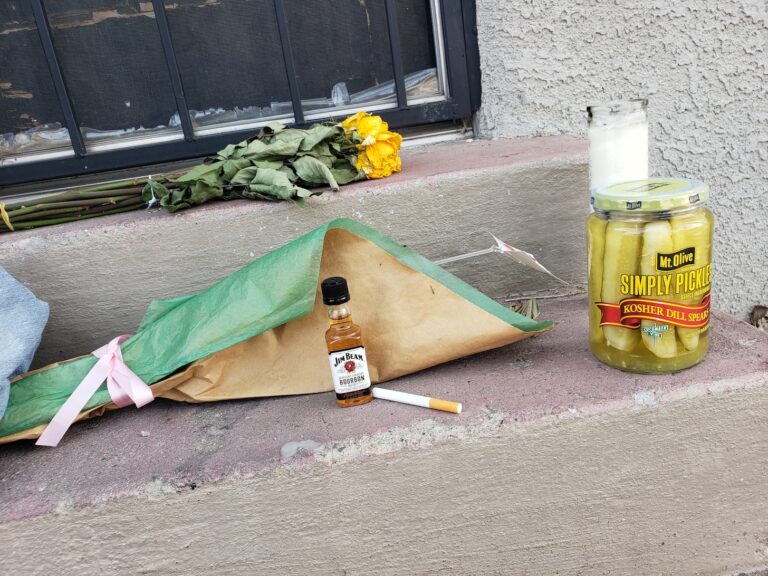On a summer evening in the Bosque of the Rio Grande Valley State Park, a symphony of insects buzz. Frogs croak intermittently. Lizards scamper in the brush and grasshoppers dart around, revealing colorful wings. A slight, New Mexico-grade humidity hangs in the air of the river forest. It’s diffused every now and then by a soft breeze that moves through the leaves of the giant cottonwoods, summoning their distinctive, otherworldly rustle. Nearby the big river ambles southward. There’s another element to this pastoral soundscape: in the distance, the hums and rattles of automobiles. Steps beyond the Bosque—just past the Pueblo Montaño Picnic Area and Trailhead—lies the vacant southeast corner at the major intersection of New Mexico State Road 448 (Coors) and Montaño. The intersection saw 150,200 vehicles per day last year. That’s probably why Walmart wants to shove another store into this sensitive location. Environmental Harmony In 1967, world-renowned, Albuquerque-based architect Antoine Predock embarked upon his first major project. This La Luz development was based on the simple concept that urban and natural environments should coexist. Buildings should respond to the landscape, and by bonding the city with nature, the isolation and generic iterations of suburbia can be overcome. La Luz was planned on 500 acres—a pristine swath of land near N.M. 448 and Montaño on the mostly undeveloped Westside. The topography transitioned from semiarid mesa down to the Bosque greenbelt. Townhouses, which occupied roughly half of the acreage, were clustered on the site’s higher ground. A school—although it didn’t open until 1994—was planned for a lower portion of the property. Meanwhile, the remainder of the site was to remain pristine."Visually, the essence of the site seemed to lie in its open sweep to the river with the sense of being part of a great valley," wrote Predock in the July-August 1969 issue of NM Architecture . He pointed out that ecologically, the river valley’s aquifer resources were vulnerable to Westside leapfrog urbanization. "Provisions for a significant large open space on the site seemed necessary." The density of the buildings—tied together with plazas, courtyards and pedestrian paths—would provoke a sense of community atypical to suburbia. Meanwhile the structures’ elevation and design would make the most of spectacular views and passive solar gain. Though the forms they took were modern and angular, they responded to the topography in shape, texture and color. Their appearance on the side of the mesa was meant to emulate natural topography. And they were of adobe construction to boot—some bricks were even made onsite, putting the project in harmony with regional building traditions as well as nature. In a few years La Luz will qualify for listing on the National Register of Historic Places. Urban Discord Since the creation of La Luz, Predock’s prediction about Westside urbanization came true. La Luz’ open space remains preserved, as do other pockets of land along Coors. But suburbia—marked by low-density housing, commercial strips, gas stations, and a labyrinthine system of streets and parking lots—has proliferated in much of the surrounding vicinity. Some of it’s good. Some of it’s bad and will require future retrofitting. Which brings us back to the corner of Coors and Montaño, and the Walmart that’s proposed for the site. In the summer of 2011, Mayor Richard Berry looked me in the eye during an interview and said that Albuquerque hasn’t become a cookie-cutter city, that we don’t want to become one. Yet Albuquerque is a city seduced by Walmart, a placeless place where, once inside, you could be anywhere in the country. The city has never denied a development plan for a Walmart. There are already three Supercenters on Coors—one of which is about two miles away from the site.The Taylor Ranch Neighborhood Association strongly and vocally opposes the development. It cites statistically high crime rates at Walmarts; the site’s close proximity to the Bosque School; an ongoing problem with traffic congestion in the area; the fact that placement of the store is in violation of the city’s big-box ordinance. In addition, commercial strips that already exist near the intersection contain grocery stores, pharmacies, optical shops, salons and local enterprises—business that Walmart undoubtedly wants to steal. And then there’s Rio Grande Valley State Park which, should the store be built at this location, would be abutted by Walmart’s backside (feel free to think about the symbolism there). Extending the length of the Rio Grande from Sandia Pueblo to Isleta Pueblo, the Bosque is Albuquerque’s Central Park—its Grant Park, its Golden Gate Park. This distinctly New Mexican greenbelt is one of Albuquerque’s greatest assets, and the spaces around it should be planned intelligently. Building what might be the most generic, placeless thing in America right next to it is certifiably stupid.Predock saw the value in Albuquerque’s Bosque, and through the controlled planning he imposed on his project, the master designer was able to preserve this natural area while introducing a man-made environment. The city is in desperate need of more of his kind of visionary thinking. We can’t take a laissez-faire approach to development. Bad planning and the diminished quality of life that results don’t just affect the people who live right next to it. It affects everyone in the city and everyone who ever visits the city. If Walmart is allowed to build a store at Coors and Montaño, it’s a sure sign that Albuquerque has no respect for itself.
Jessica Cassyle Carr is the Weekly Alibi's music editor. This fall she finishes her graduate certification in Historic Preservation and Regionalism via UNM's School of Architecture and Planning. She likes vinyl records and vernacular architecture. The opinions expressed are solely those of the author.This issue will be taken up at the next Council meeting, set for 5 p.m. on Monday, Aug. 20, in the Council Chambers in the basement of City Hall. You can also view it on GOV TV 16 or at cabq.gov/govtv.









